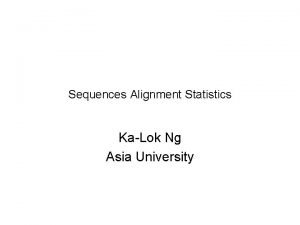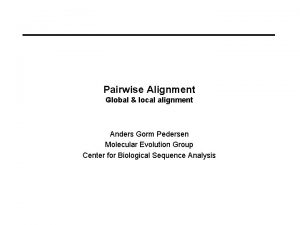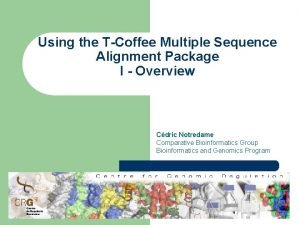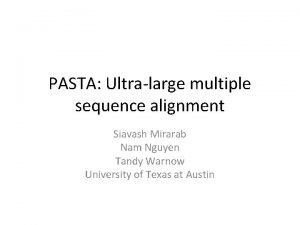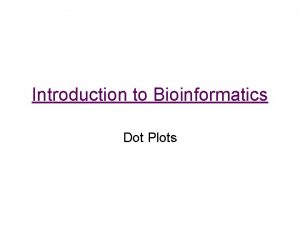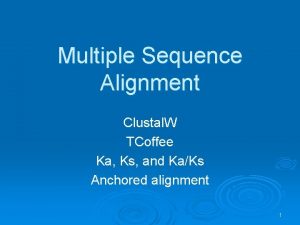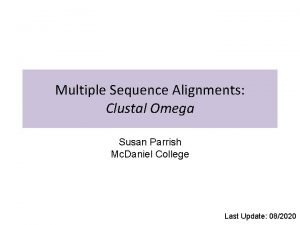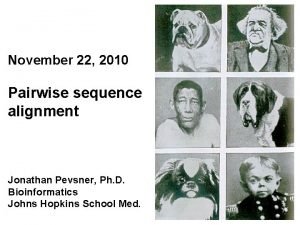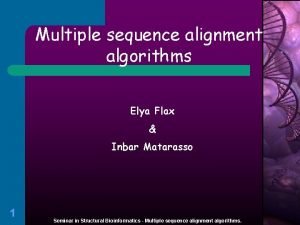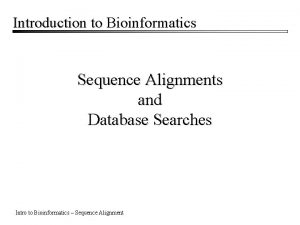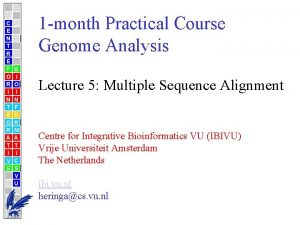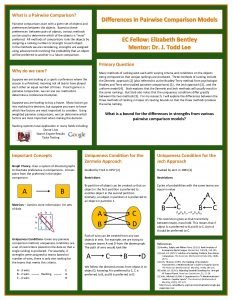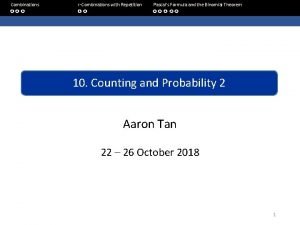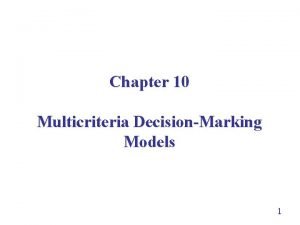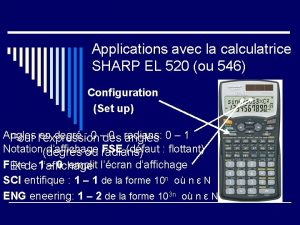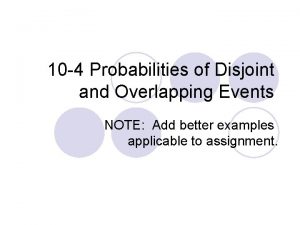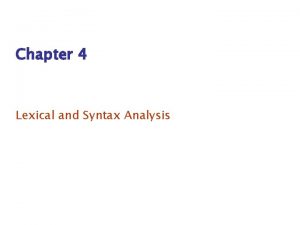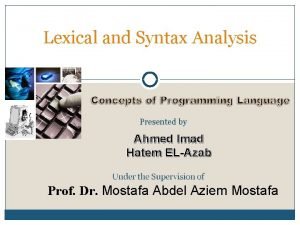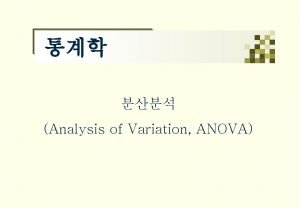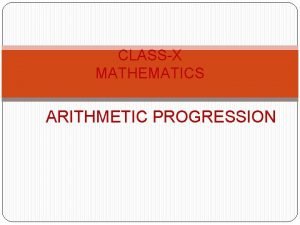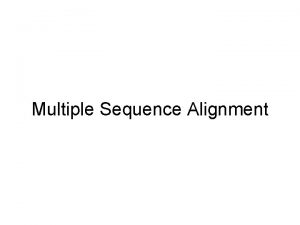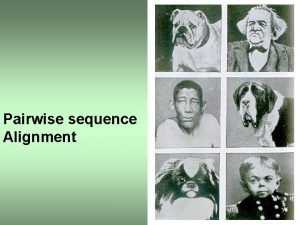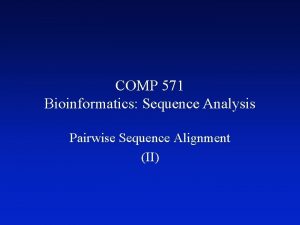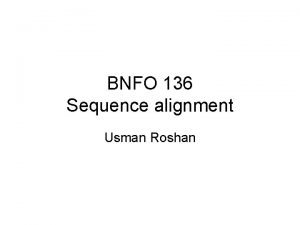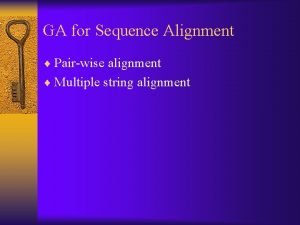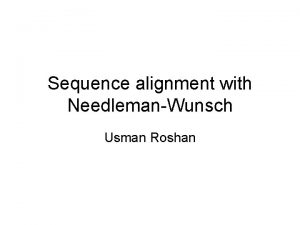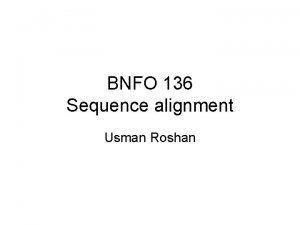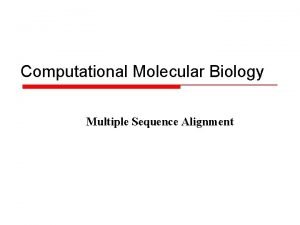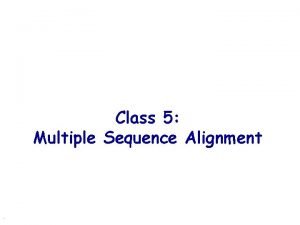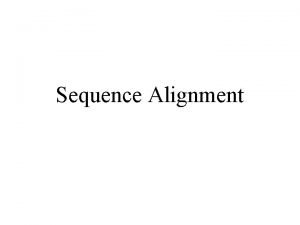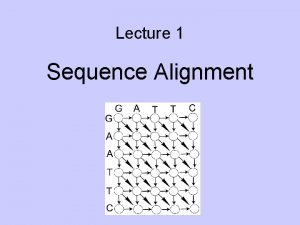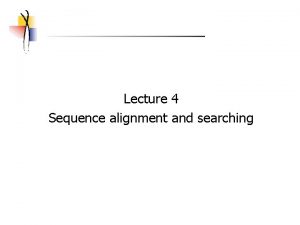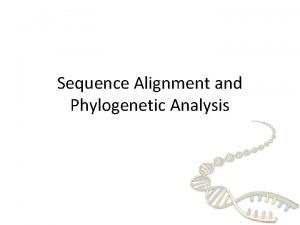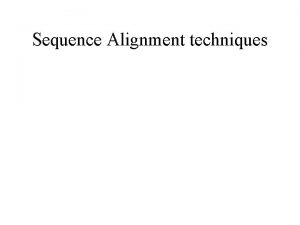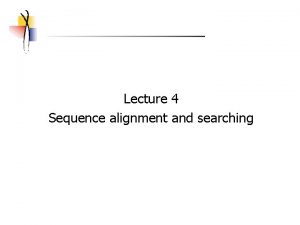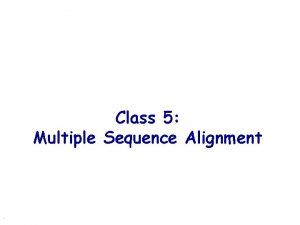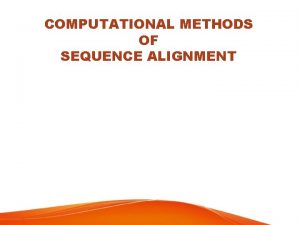Pairwise Sequence Alignment LESSON 3 1 Alignment l























































- Slides: 55

Pairwise Sequence Alignment LESSON 3 -1



Alignment l. Comparison of different DNA or protein sequences Ø Identifying regions of similarity Ø Functional, structural, or evolutionary relationships between the sequences. • key stage in the analysis of newly found sequences • Important part of bioinformatics

Why “Similarity”? Similar sequences Similar structure Similar function Function prediction

Similarity vs. Homology Similarity Homology Degree of match Evolutionary implication Quantifiable value Binary relationship ? % Homologous ? Non-homologous?

How similar must sequences be in order to be considered homologous? homologous >25 % of the amino acids present for proteins >70 % of the nucleotides present for DNA

2 types of Homology Orthologs Homologous sequences in different species Paralogs Homologous sequences within a single species

Pairwise Multiple

Pairwise Sequence Alignment The process of lining up two sequences to achieve maximal levels of identity. for the purpose of assessing the degree of similarity and the possibility of homology.

Alignment l Line up sequences! l To maximize their similarity T H I S S E Q U E N C E 10/12 = 83. 3% T H A T S E Q U E N C E

Line up sequences! To maximize their similarity T H I S A S E Q U E N C E │ │ T H A T S E Q U E N C E tions l Introduce gaps Posi : s p a G tte a le h c i h w at with a d e r i a r is p T H I S A - S E Q U E N C E T H - - A T S E Q U E N C E null

Percentage identity (% ID) T H I S A S E Q U E N C E │ │ T H A T S E Q U E N C E 4/15 = 27% T H I S A - S E Q U E N C E │ │ │ │││ │ T H - - A T S E Q U E N C E 11/16 = 69%

The quality of an alignment Is measured by giving it a quantitative score Optimal alignment -> Best score! The simplest way of quantifying similarity between two sequences Percentage identity (% ID)

Dotplot Visual assessment of similarity based on identity THISSEQUENCE THISISASEQUENCE

Dotplot The similarity appears in parallel diagonals. The parallel shifts indicate that there are gaps. Insertions/Deletions THIS---SEQUENCE THISISASEQUENCE

Dotlet • Dot-plot programs available over the internet • http: //myhits. isb-sib. ch/cgi-bin/dotlet • Java applet


Filter Windows of 10 residue Minimum identity score of 3


Low-complexity regions e. g. Plasmodium falciparum serine-repeat antigen protein precursor

Plasmodium falciparum serine-repeat antigen protein precursor

Repeated protein domains e. g. Drosophila melanogaster SLIT protein

Drosophila melanogaster SLIT protein against itself

Conserved protein domains

Exons and introns



C. elegans Daf-2 human IGF 1 R

C. elegans Daf-2 Human IGF 1 R C. elegans Daf-2

Daf-2 IGF 1 R Identity or similarity (+)

Score from MATRIX


Scoring Matrix 1. Identity matrix 2. Substitution matrix PAM BLOSUM

How to use scoring matrices q Using the identity matrix (e. g. match=1 and mismatch=− 1) q Summing the value at all position KAWSADV KDWSAEV 1− 1+1+1+1− 1+1=3

Genuine matches do not have to be identical l Percentage identity is a crude and does not give a complete picture of the degree of similarity l. Certain amino acids resemble each other Ø substitute functionally for each other

Identical amino acids : highest score (BLOSUM 62) Substitution Matrix Pairs of amino acids with similar properties score more highly than those with quite different properties Pairs of cysteins(C) and tryptophans(W) : high value Important structure Disulfide bonds / hydrophobic core of protein KAWSADV KDWSAEV 5− 2+11+4+4+2+4 = 28

(PAM 250 matrix) Substitution Matrix KAWSADV KDWSAEV 5+0+17+2+2+3+4 = 33 KAWSADV KYWSAEV 5 -3+17+2+2+3+4 = 30

Substitution Matrices constructed by assembling a large and diverse sample of verified alignments of amino acids. values proportional to the probability of mutations PAM BLOSUM

PAM (percentage accepted mutations) matrix Dayhoff model : accepted point mutation Mutation probability Matrix how often a given amino acid is exchanged for another in already aligned similar sequences. “PAM N” matrix : N substitutions per hundred residues. PAM 0 PAM 1 the proteins have undergone 1% change (= 1 point mutation per 100 amino acid residues).

Dayhoff’s PAM 1 mutation probability matrix Each element of the matrix shows the probability that an original amino acid (top) will be replaced by another amino acid (side)

PAM matrix “PAM N” matrix : N substitutions per hundred residues. PAM 0 PAM 1 : the proteins have undergone 1% change (= 1 point mutation per 100 amino acid residues). PAM 100? PAM 250? Multiplied the PAM 1 matrix by itself 250 times.

PAM 250 mutation probability matrix

Mutation Probability Matrix → Log-Odds Scoring Matrix Logarithms are easier to use for a scoring system. sum the scores of aligned residues (rather than having to multiply them). The score S for an alignment of residues i, j ← probability of aligning j with i ← likelihood of i by chance for tryptophan, S(trp, trp) =

Normalized frequencies of amino acids Gly Ala Leu Lys Ser Val Thr Pro Glu Asp 8. 9% 8. 7% 8. 5% 8. 1% 7. 0% 6. 5% 5. 8% 5. 1% 5. 0% 4. 7% Arg Asn Phe Gln Ile His Cys Tyr Met Trp (These frequencies sum to 1) 4. 1% 4. 0% 3. 8% 3. 7% 3. 4% 3. 3% 3. 0% 1. 5% 1. 0%

Mutation Probability Matrix → Log-Odds Scoring Matrix Logarithms are easier to use for a scoring system. sum the scores of aligned residues (rather than having to multiply them). The score S for an alignment of residues i, j ← probability of aligning j with i for tryptophan, ← likelihood of i by chance (background probability) S(trp, trp) = 10 log (0. 55/0. 010) = 17. 4

PAM 250 Log Odds Scoring Matrix

Substitution Matrices percentage accepted mutations (PAM) matrices blocks substitution matrix (BLOSUM) Blocks : conserved regions “BLOSUM N” matrix Sequences are clustered together if they have ≥ N% identity. BLOSUM 62, in the case where N = 62%. BLOSUM 80?

Choice of Substitution Matrices depends on the problem. ü BLOSUM matrices with higher numbers and PAM matrices with low numbers are designed for comparisons of closely related sequences. q The PAM matrix number indicates evolutionary distance q The BLOSUM matrix number refers to percentage identity

Calculation of an alignment score

Gaps Must be introduced judiciously ( )ﺑﺤﻜﻤﺔ Forcing two sequences to match up simply by inserting large numbers of gaps will not reflect reality and will produce meaningless alignment The best alignment is The maximum score for the smallest number of gaps. Limit! Gap scores are typically negative.

Gap penalty Gap scores are typically negative. Each time a gap is introduced, the penalty is subtracted. T H I S A - S E Q E N C E T H - - A T S E Q E N C E 5 8 -2 -2 4 5 5 5 6 9 5 46 36

• High gap penalty setting • 10 % identity • Low gap penalty setting • 18 % identity

Gap penalty Gap scores are typically negative. Since a single mutational event may cause the insertion or deletion of more than one residue, the presence of a gap is ascribed more significance than the length of the gap. separate penalties for gap creation and gap extension.

First gap position scores -11 Second gap position scores -1 Gap creation tends to have a large negative score; Gap extension involves a small penalty
 Blast pairwise alignment
Blast pairwise alignment Ebi pairwise alignment
Ebi pairwise alignment Pairwise alignment
Pairwise alignment Pairwise alignment
Pairwise alignment Tcgcat
Tcgcat Global alignment example
Global alignment example Dna substitution
Dna substitution Sequence alignment
Sequence alignment Global and local alignment in bioinformatics
Global and local alignment in bioinformatics Jonathan pevsner
Jonathan pevsner Tcoffee alignment
Tcoffee alignment Pasta alignment
Pasta alignment Bioedit clustalw
Bioedit clustalw Dot plot bioinformatics example
Dot plot bioinformatics example Tcoffee multiple sequence alignment
Tcoffee multiple sequence alignment Progressive multiple sequence alignment
Progressive multiple sequence alignment Cluster omega
Cluster omega A named sequence of statements is known as
A named sequence of statements is known as Sequence alignment
Sequence alignment Sequence alignment
Sequence alignment Hirschberg's algorithm
Hirschberg's algorithm What is gap penalty in bioinformatics
What is gap penalty in bioinformatics Praline multiple sequence alignment
Praline multiple sequence alignment Pairwise comparison
Pairwise comparison Pairwise independent
Pairwise independent Greedy algorithm
Greedy algorithm Comparison chart design
Comparison chart design Pairwise independent
Pairwise independent Pairwise correlation
Pairwise correlation Pairwise disjointness test
Pairwise disjointness test Pairwise comparison matrix
Pairwise comparison matrix Sharp el-546x
Sharp el-546x Disjoint probability
Disjoint probability Pairwise key
Pairwise key Pairwise disjointness test example
Pairwise disjointness test example Listwise vs pairwise
Listwise vs pairwise Pairwise disjointness test
Pairwise disjointness test Tukey pairwise comparison minitab
Tukey pairwise comparison minitab Pairwise.org
Pairwise.org Pict tool
Pict tool Pairwise comparison anova
Pairwise comparison anova Amino acid nucleotide
Amino acid nucleotide What is a pseudocode with example?
What is a pseudocode with example? Sum of a finite arithmetic series
Sum of a finite arithmetic series Convolutional sequence to sequence learning.
Convolutional sequence to sequence learning. Constructive alignment of the components of a lesson plan
Constructive alignment of the components of a lesson plan Constructive alignment model
Constructive alignment model Arithmetic sequence lesson plan
Arithmetic sequence lesson plan Lesson outline lesson 3 describing circuits answers
Lesson outline lesson 3 describing circuits answers Lesson outline lesson 3 mountain building answers
Lesson outline lesson 3 mountain building answers Lesson outline lesson 2 aquatic ecosystems answer key
Lesson outline lesson 2 aquatic ecosystems answer key Macro teaching lesson plan
Macro teaching lesson plan L 101 lesson 2
L 101 lesson 2 A gift of chappals introduction
A gift of chappals introduction Lesson 1 your total health
Lesson 1 your total health Lesson outline lesson 3 weather forecasts answer key
Lesson outline lesson 3 weather forecasts answer key


